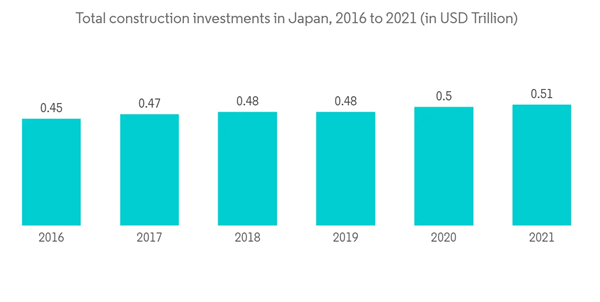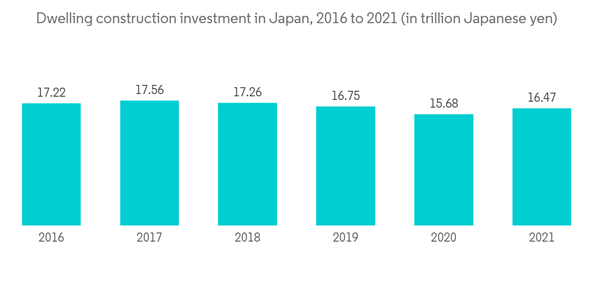The Japan Construction Market size is estimated at USD 609.27 billion in 2024, and is expected to reach USD 716.66 billion by 2029, growing at a CAGR of 3.30% during the forecast period (2024-2029).
Tokyo is considering partnering with India on international infrastructure development initiatives. Joint planning, design, and implementation of infrastructure projects in nations like Nepal, where both countries are already engaged in projects, might aid New Delhi and Tokyo in maximizing their effect. India's less innovative and more affordable digital solutions are suitable for developing nations, especially those in Southeast Asia. Infrastructure development has been a priority for Japanese businesses and government agencies in East Africa, Vietnam, Indonesia, and Cambodia.
Beijing has increased its influence in the area by using infrastructural assistance due to China's Belt and Road Initiative. However, claims of "debt-trap diplomacy" have plagued Chinese sponsorship. The four-nation Quad established a working group on infrastructure since it is now a crucial aspect of the growing diplomatic rivalry in the area.
The government took action in 2021 to help families with children buy homes by providing incentives for brand-new construction. Notably, the government offered incentives for the scheme that ranged from JPY 600,000 to JPY 1,000,000 per unit. The initiative began in November 2021 after receiving financing of JPY 54.2 billion (USD 0.42 billion) under the fiscal 2021 additional budget.
The government allocated an additional JPY 60 billion (USD 0.46 billion) for the program in 2022. The government also extended the deadline from the end of October 2022 to the end of March 2023 due to the expectation that 120,000 applications will be submitted for the subsidies. Over the next 3-4 years, these government initiatives may increase the expansion of the residential building sector by reducing the demand from Japanese homebuyers.
The key players in the Japanese construction market are Obayashi Corp., Mitsubishi Heavy Industries Ltd, Nippon Concrete Industries, Takada Corporation, The Zenitaka Corp., Sumitomo Mitsui Construction Co. Ltd, and Toshiba Corp.
This product will be delivered within 2 business days.
Key Highlights
- The construction industry is an important pillar of the Japanese economy that generated around 5.5% of the gross domestic product (GDP) in 2021. Reconstruction following the Great East Japan Earthquake and the Tokyo Olympics have contributed to the industry's general rising trend over the past 10 years. While there are more than 470,000 registered construction firms in Japan, the industry is dominated by Super Zenecon, a group of five large general contractors, namely Obayashi Corporation, Tasei Corporation, Kajima Corporation, Shimizu Corporation, and Taneka Corporation. They have combined annual sales of more than JPY 1 trillion and operate in various industries, including construction, architectural design, and R&D.
- The Japanese construction industry has recovered during the past 10 years from a period of stagnation that had lasted since the economic bubble burst in the 1990s. Recovery was aided in part by the reconstruction efforts that followed the Great East Japan Earthquake in 2011. The 2021 Tokyo Olympic Games served as a major demand generator in recent years. Both the Chuo Shinkansen maglev line's development and other building projects slated for the Osaka World Expo 2025 are anticipated to have a similar effect.
- The government will invest around JPY 15 trillion (USD 0.12 trillion) as part of its five-year acceleration plan for disaster prevention, mitigation, and national resilience, which is likely to boost the demand for construction work in the coming years.
- Strong international demand for Japanese exports and the record JPY 55.7 trillion (USD 490 billion) fiscal stimulus package approved by the government are aiding the country's construction production. The government of Japan is investing JPY 774 billion (USD 6.8 billion) in the semiconductor sector, supporting growth and prioritizing the expansion of local production of next-generation semiconductors.
Japan Construction Market Trends
Increase in Infrastructure Developments Boosting the Market
The urban infrastructure of Japan is among the greatest in the world. Japan's strategy for infrastructure development was in response to many stages, each emphasizing the significance of striking a balance between economic growth and sustainability. In August 2022, the Japanese government ordered the construction of a new nuclear plant. Notably, the construction and development of the new nuclear plant will help the country reduce its reliance on energy imports amid the global energy crunch.Tokyo is considering partnering with India on international infrastructure development initiatives. Joint planning, design, and implementation of infrastructure projects in nations like Nepal, where both countries are already engaged in projects, might aid New Delhi and Tokyo in maximizing their effect. India's less innovative and more affordable digital solutions are suitable for developing nations, especially those in Southeast Asia. Infrastructure development has been a priority for Japanese businesses and government agencies in East Africa, Vietnam, Indonesia, and Cambodia.
Beijing has increased its influence in the area by using infrastructural assistance due to China's Belt and Road Initiative. However, claims of "debt-trap diplomacy" have plagued Chinese sponsorship. The four-nation Quad established a working group on infrastructure since it is now a crucial aspect of the growing diplomatic rivalry in the area.
Government Funding is Being Used as a Development Driver for Japan's Residential Construction Sector
The Japanese government has been providing housing subsidies to families with children for the past few years. In 2022, this tendency was anticipated to intensify. The land ministry intends to expand the lineup of measures after establishing a variety of policies and measures, such as tax incentives for individuals who take out mortgages to help with home purchases, to ease the financial burden of home ownership in Japan.The government took action in 2021 to help families with children buy homes by providing incentives for brand-new construction. Notably, the government offered incentives for the scheme that ranged from JPY 600,000 to JPY 1,000,000 per unit. The initiative began in November 2021 after receiving financing of JPY 54.2 billion (USD 0.42 billion) under the fiscal 2021 additional budget.
The government allocated an additional JPY 60 billion (USD 0.46 billion) for the program in 2022. The government also extended the deadline from the end of October 2022 to the end of March 2023 due to the expectation that 120,000 applications will be submitted for the subsidies. Over the next 3-4 years, these government initiatives may increase the expansion of the residential building sector by reducing the demand from Japanese homebuyers.
Japan Construction Industry Overview
The market is fragmented and expected to grow during the forecast period due to the increase in construction investments and upcoming major projects in the country. However, the market provides chances for small and medium-sized businesses due to the rising government spending in the industry. During the forecast period, the Japanese construction market has the potential for expansion, which may increase market competitiveness.The key players in the Japanese construction market are Obayashi Corp., Mitsubishi Heavy Industries Ltd, Nippon Concrete Industries, Takada Corporation, The Zenitaka Corp., Sumitomo Mitsui Construction Co. Ltd, and Toshiba Corp.
Additional Benefits:
- The market estimate (ME) sheet in Excel format
- 3 months of analyst support
This product will be delivered within 2 business days.
Table of Contents
1 INTRODUCTION
4 MARKET DYNAMICS
5 MARKET SEGMENTATION
6 COMPETITIVE LANDSCAPE
Companies Mentioned (Partial List)
A selection of companies mentioned in this report includes, but is not limited to:
- DAIWA HOUSE INDUSTRY CO., LTD.
- SEKISUI HOUSE, LTD.
- OBAYASHI CORPORATION
- KAJIMA CORPORATION
- SHIMIZU CORPORATION
- TAISEI CORPORATION
- TAKENAKA CORPORATION
- SUMITOMO FORESTRY CO., LTD.
- HASEKO CORPORATION
- JGC HOLDINGS CORPORATION
Methodology

LOADING...










